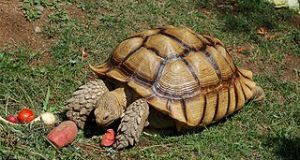Note: For further information on red eared sliders in the wild and captivity, please see The Red Eared Slider in Outdoor Ponds and Typical and Atypical Habitats of the Red Eared Slider
The red eared slider is familiar to herp enthusiasts the world over, but many of its relatives are not. As one of the many subspecies of the common slider, the red-ear is cousin to a surprising variety of rare and poorly studied turtles.
Widely-ranging Subspecies
The red-eared slider is one of 15 described subspecies of the common slider, Trachemys scripta. The common slider is considered to be the most variable, in terms of physical appearance, of all turtles, and has a huge natural range. Common sliders of one variety or another may be found from southeastern Virginia to northern Florida, west to Kansas and New Mexico and south through Mexico to northern Columbia and Venezuela.
A Slider among Sea Turtles
The most “exotic” slider subspecies that I have handled are the Nicaraguan slider, Trachemys s. emolli, which was shown to me by a friend in Costa Rica, and the Meso-American slider, Trachemys s. venusta. I encountered the Meso-American slider at Tortuguero, Costa Rica, where it nests on ocean beaches amidst green and leatherback turtles.
It is said that Meso-American sliders wash out to the sea from the mouths of nearby rivers, then make their way to the beaches to nest…but I have not heard an explanation of how they negotiate the return trip. In any event, I have observed them in large rivers and can attest to the fact that at least some individuals nest on ocean beaches, right along with sea turtles.
Sliders in the Desert and Box Turtles in Water
Perhaps the rarest of all slider subspecies is the Cuatro Cienegas slider, Trachemys s. taylori, found only in the Cuatro Cienegas Basin of Coahuila, Mexico. Smack in the middle of the Chihuahuan Desert, this 500 square mile oasis is also home to another very rare and unusual turtle – Coahuilan box turtle, Terrapene coahuila. Long isolated from related species, the 75+ animal species endemic to Cuatro Cienegas have developed a host of unusual survival strategies. The Coahuilan box turtle, for example, is unique among all box turtles in spending most of its life in water.
I’ve worked with Coahuilan box turtles in captivity…its hard to describe how strange it is to see them bobbing about in deep water. With their highly-domed shells, they seem completely unsuited for a watery existence, yet get along quite well. Their future in the wild is tenuous at best, but they breed very well in captivity.
Further Reading
An interesting article on the unique reptiles and amphibians of the Cuatro Cienegas Basin is posted at http://www.desertfishes.org/cuatroc/literature/cc_symp1/4/j4.html.
 That Reptile Blog – Reptile, Amphibian and Exotic Pet Care and Information
That Reptile Blog – Reptile, Amphibian and Exotic Pet Care and Information


